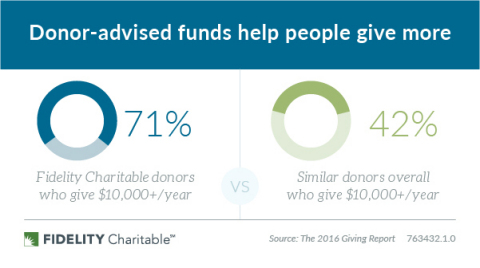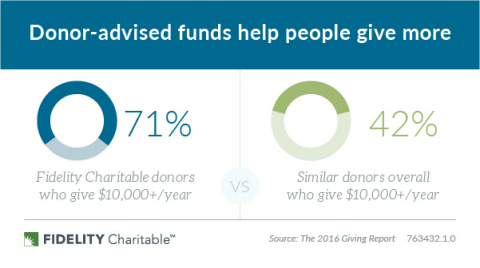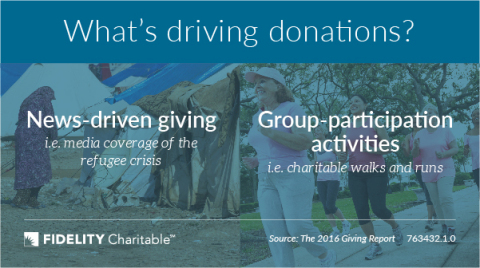BOSTON--(BUSINESS WIRE)--An analysis of the giving behavior of more than 132,000 Fidelity Charitable® donors in the 2016 Fidelity Charitable Giving Report, released today, reveals key trends that drove where donors chose to give. In addition, survey data provides insight into key differences between charitable donors who use donor-advised funds (DAFs) for their giving compared to a national pool of donors1. The report is the fourth annual produced by Fidelity Charitable, an independent public charity with one of the nation's largest donor-advised fund programs, and the nation’s second largest grantmaker, with cumulative grants of more than $22 billion since its inception 25 years ago.
Relief Efforts and Social Giving Drove Giving
Relief efforts and social giving efforts, such as charity walks, were key in motivating donors to give last year, based on analysis of shifts in ranking of the most popular charities supported by Fidelity Charitable donors. Spikes in support of specific charities on the list included those providing relief to victims of the earthquake in Nepal and the humanitarian crisis in Syria. Reflecting this trend, UNICEF and OXFAM saw 38% and 35% increases, respectively, in the number of donors supporting them.
Group-participation in giving activities, such as charitable walks and runs, also influenced movement among the ranking of the top charities supported by Fidelity Charitable donors. Organizations that appeared to be particularly successful in galvanizing donors included several nonprofits focused on healthcare and medical research, including the Alzheimer’s Association, which saw a 39% increase in grants recommended by Fidelity Charitable donors and The Pan-Mass Challenge, a Massachusetts-based bike-a-thon that raises money for cancer research, which saw a 26% increase in grants from Fidelity Charitable.
“Fidelity Charitable donors support an extraordinary range of organizations, with more than 106,000 nonprofits receiving grants last year,” says Amy Danforth, president of Fidelity Charitable. “While most who give have organizations and causes that they support year-in and year-out, those who use donor-advised funds have a dedicated account for charitable giving, which enables them not only to provide ongoing support to their favorite charitable causes, but also to more easily and quickly respond to meet new needs as they emerge.”
Charitable donors who give with a donor-advised fund give and consult others more
The report also uncovered fundamental differences in giving habits between those who use donor-advised funds and donors surveyed who do not.
Key among these findings was that DAF donors provide more support for more charities than their counterparts who do not use donor advised funds. Over 70% of Fidelity Charitable donors give more than $10,000 per year2, while only 42% of similar donors who do not use DAFs give the same annual amount. Significantly, 85% of DAF donors support six or more charities, compared to 36% of donors surveyed who do not use DAFs.
Fidelity Charitable donors are also significantly more likely to involve other members of their households when making decisions on giving. Sixty-two percent of Fidelity Charitable Giving Accounts have multiple donors with advisory privileges, those permitted to recommend grants. In addition, 82% of DAF donors engage others in their households in their decision making process versus 53% of donors surveyed who do not use DAFs.
“Our finding that donors with donor-advised funds are having more conversations about giving within their households and, ultimately, giving more to charities than donors who do not use donor-advised funds, demonstrates that having dedicated funds for giving encourages a more planned, thoughtful approach to philanthropy,” Danforth says. “Best of all, this results in donors who provide greater and more dependable support to charities.”
Retirees have greater confidence in future giving, give at higher levels
Retirees who give with a donor-advised fund feel more assured that they will be able maintain or increase their giving in retirement, with 62% of retired Fidelity Charitable donors who feel confident compared to 52% of retirees surveyed who do not use DAFs. In addition, 70% of retired Fidelity Charitable donors reported that they give more than $10,000 to charity each year, compared to just 27% of retired donors surveyed who do not use DAFs.
“The waves of baby boomers who will continue to retire over the coming decades are expected to be significant drivers of charitable giving,” Danforth says. “We know that many donors set up their accounts as a way to prepare to maintain or grow their giving in retirement; our finding that most have high confidence that they will be able to continue to support charities at their current levels in the future indicates that this is often a very successful strategy.”
Higher donations of appreciated assets result in more to give
Compared to donors nationally, Fidelity Charitable donors are significantly more likely to contribute appreciated assets, which may be one key reason they are able to give more. Sixty percent of Fidelity Charitable donors contributed non-cash assets, such as long-term appreciated stocks and real estate, last year, compared to 19% of donors nationally who have ever done so.
Due to the tax benefits of donating long-term appreciated securities, donors who give non-cash assets directly to charity may be able to give up to 20% more compared to liquidating a non-cash asset and making a cash contribution. In 2015, two thirds of contributions to Fidelity Charitable were made with non-cash assets, up significantly from the previous year.
“A key benefit of using a donor-advised fund is that you can make a single donation of long-term appreciated securities and use that one contribution to support multiple charities,” Danforth explains. “People who give want to maximize the positive impact their donations have on the organizations they support. We are proud of the essential role we play in helping our donors achieve that goal.”
Highlights from the report include:
- 85% of Fidelity Charitable donors support six or more charities, compared to 36% of affluent donors
- Two-thirds of donor contribution dollars to Fidelity Charitable were non-cash assets, an 18% increase from the previous year
- 60% of donors contributed appreciated assets to Fidelity Charitable last year, compared to just 19% of affluent donors at any time in their giving history
- 82% of Fidelity Charitable donors engage others in the decision-making process around their giving versus 53% of similar donors
- 62% of retired Fidelity Charitable donors feel confident about ability to give in the future. In comparison, only 52% of similar retirees have the same confidence
- 71% of Fidelity Charitable donors give more than $10,000 per year, while 42% of similar donors overall give the same amount
- Among retired donors, 70% of Fidelity Charitable donors reported that they give $10,000 or more vs. just 27% among similar retired donors
- 92% of donations allocated to Giving Accounts at Fidelity Charitable are distributed to charities within 10 years of receipt by Fidelity Charitable
- The number of charities supported by Fidelity Charitable donors increased 100% in 10 years, from 53,076 to 106,250
About Fidelity Charitable
Fidelity Charitable is an independent public charity that has helped donors support more than 219,000 nonprofit organizations with more than $21 billion in grants. Established in 1991, Fidelity Charitable launched the first national donor-advised fund program. The mission of the organization is to further the American tradition of philanthropy by providing programs that make charitable giving simple, effective, and accessible. For more information about Fidelity Charitable, visit http://www.fidelitycharitable.org.
Fidelity Charitable is the brand name for the Fidelity® Charitable Gift Fund, an independent public charity with a donor-advised fund program. Various Fidelity companies provide services to Fidelity Charitable. The Fidelity Charitable name and logo and Fidelity are registered service marks of FMR LLC, used by Fidelity Charitable under license.
763210.1.0
© 2016 Trustees of Fidelity Charitable. All rights
reserved.
1 Fidelity Charitable donor results are based on surveys of Fidelity Charitable donors and Fidelity Charitable’s internal reporting database. Results among affluent donors are based on a survey of people who give to charity who have more than $100,000 in investable assets.
2 Survey statistics in the Giving Report spotlight section refer to Fidelity Charitable donors’ total reported giving, including direct giving as well as grants recommended, from their Giving Account





